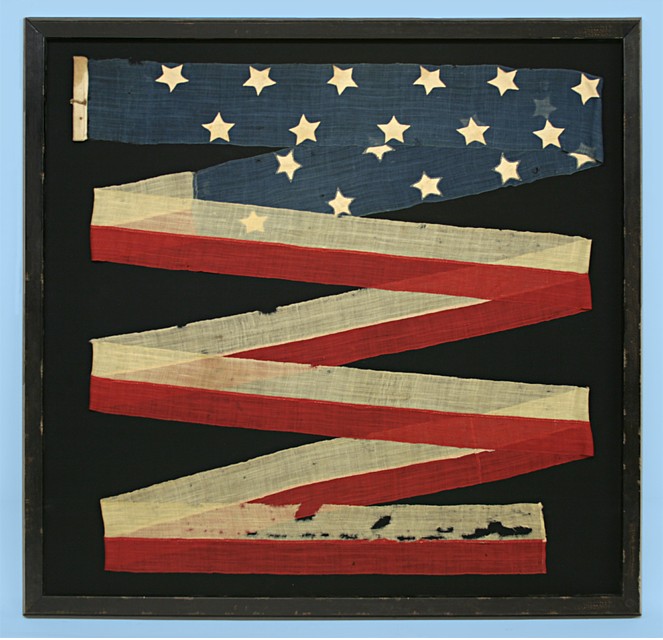
| |
EXCEPTIONALLY RARE AND EARLY, 20 STAR U.S. NAVY COMMISSIONING PENNANT, 1818-1819 |
|
| Available: |
Sold |
| Frame Size (H x L): |
68" x 70.5" |
| Flag Size (H x L): |
9" x 395" (32.9ft) |
|
| Description....: |
|
EXCEPTIONALLY RARE AND EARLY, 20 STAR U.S. NAVY COMMISSIONING PENNANT. THE OFFICIAL STAR COUNT FOR APPROX. ONE YEAR, 1817-1818:
Commissioning pennants are the distinguishing mark of a commissioned U.S. Navy ship. A ship became commissioned when this pennant was hoisted, and the commissioning pennant is flown during both times of peace and war, and is only not flown if a flag officer or civilian official is aboard and replaces it with their own flag.
This pennant is earlier than any Stars & Stripes national flag I have ever had the pleasure to acquire, as American flags of this period are practically non-existent among surviving examples. Its 20 stars reflect the official count per the flag act of 1818. Mississippi became the 17th state on December 10th, 1817, and the flag was updated from the previously official 15 stars to 20 stars on April 13th,, 1818. It was the official count for only one year, replaced by 21 stars on July 4th, 1819.
Today such pennants do not exceed six feet, but early pennants needed to be prominent in order to serve their purpose as signals. This particular example is thirty-two feet in length, having lost a small portion of its fly end from wind whip. Such pennants often exceed twenty feet and lengths of over fifty feet are not unheard of.
Early on the pennants would typically have a number of stars that reflected the number of states, like this example. As time progressed, however, and more and more states were added, number of stars was reduced to either 13 (to reflect the original number of states) or 7 stars. After approximately 1900, all pennants had 7 stars. According to the U.S. Navy, the reason for the choice of 7 stars was not recorded. I believe that it either represents the 7 seas, or may have simply been what seemed to be a logical design choice when these pennants were substantially shortened. Today the largest commissioning pennants measure two-and-a-half by six feet.
Construction: The body of the pennant is made of hand-sewn wool bunting. Note the irregularity in the weave as is the characteristic of maritime flags made during the 1st quarter of the 19th century. The stars are made of cotton, hand-sewn, and single-appliqued. This means that they were applied to one side of the canton, then the blue fabric was cut from behind each star, folded over, and under-hemmed so that one appliqued star could be visible on both sides of the flag. The hoist is made of a wooden bar that has been covered in coarse linen or hemp and there is a loop of hemp rope threaded through a hand-sewn grommet.
Mounting: The pennant has been hand-stitched to 100% cotton, black in color, which has been washed and treated to reduce and set the dye. A shadowbox was created to accommodate the folding of the textile. The front is u.v. protective plexiglas.
Condition: There is some fabric loss, but it is extraordinarily limited for such an early wool flag. Some length has been lost through regular use and the fly end was, at some point, appropriately turned back and hemmed. The tip of the pennant would have originally been forked or tapered. |
|
|
|
| Collector Level: |
Flags for the truest Patriots. My best offerings |
|
| Flag Type: |
Sewn flag |
|
| Star Count: |
20 |
|
| Earliest Date of Origin: |
1818 |
|
| Latest Date of Origin: |
1819 |
|
| State/Affiliation: |
Mississippi |
|
| War Association: |
1777-1860 Pre-Civil War |
|
| Price: |
Sold |
|
| |
Views: 3076 |
|
|
|

